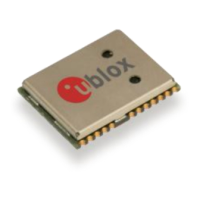NEO-8Q / NEO-M8 - Hardware Integration Manual
UBX-15029985 - R04 Production Information Product handling
Page 25 of 31
EOS protection measures
For designs with GNSS positioning modules and wireless (e.g. cellular) transceivers in close proximity, ensure
sufficient isolation between the wireless and GNSS antennas. If wireless power output causes the specified
maximum power input at the GNSS RF_IN to be exceeded, employ EOS protection measures to prevent
overstress damage.
For robustness, EOS protection measures as shown in Figure 13 are recommended for designs combining
wireless communication transceivers (e.g. cellular) and GNSS in the same design or in close proximity.
Small passive antennas (<2 dBic and
performance critical)
Passive antennas (>2 dBic or
performance sufficient)
Active antennas (without internal filter which need the
module antenna supervisor circuits)
RF_IN
GNSS
Receiver
LNA
GPS
Bandpass
Filtler
RF_IN
GNSS
Receiver
L
GPS
Bandpass
Filtler
LNA with appropriate ESD rating and
maximum input power
GNSS Band pass Filter: SAW or
Ceramic with low insertion loss and
appropriate ESD rating
Figure 13: EOS and ESD Precautions
Electromagnetic interference (EMI)
Electromagnetic interference (EMI) is the addition or coupling of energy causing a spontaneous reset of the
GNSS receiver or resulting in unstable performance. In addition to EMI degradation due to self-jamming (see
section 1.5) any electronic device near the GNSS receiver can emit noise that can lead to EMI disturbances or
damage.
The following elements are critical regarding EMI:
Unshielded connectors (e.g. pin rows etc.)
Weakly shielded lines on PCB (e.g. on top or bottom layer and especially at the border of a PCB)
Weak GND concept (e.g. small and/or long ground line connections)
EMI protection measures are recommended when RF emitting devices are near the GNSS receiver. To minimize
the effect of EMI a robust grounding concept is essential. To achieve electromagnetic robustness follow the
standard EMI suppression techniques.
http://www.murata.com/products/emc/knowhow/index.html
http://www.murata.com/products/emc/knowhow/pdf/4to5e.pdf
Improved EMI protection can be achieved by inserting a resistor or better yet a ferrite bead or an inductor (see
Table 6) into any unshielded PCB lines connected to the GNSS receiver. Place the resistor as close as possible to
the GNSS receiver pin.
Alternatively, feed-thru capacitors with good GND connection can be used to protect e.g. the VCC supply pin
against EMI. A selection of feed-thru capacitors are listed in Table 6.
Intended use
In order to mitigate any performance degradation of a radio equipment under EMC disturbance, system
integration shall adopt appropriate EMC design practice and not contain cables over three meters on signal
and supply ports.

